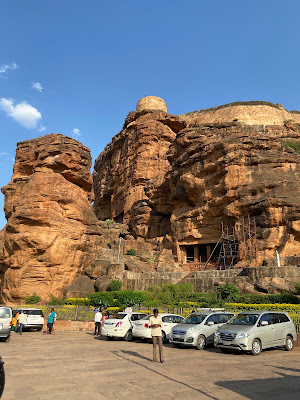Varaha Roopam at Badami
Varaha Roopam…..The
caller tune of the cabbie’s cell phone kept intruding on my reverie as we sped
along the highway to Badami. I was totally oblivious about the origins of the
melody and I was shy to ask him. Later that afternoon, the melody broke out in
my lips as I stood transfixed in front of the real Varaha Roopam in cave number
3. Vishnu’s third incarnation hasn’t been depicted in a more grandiloquent manner.
The boar is holding aloft Bhudevi, the mother goddess of earth, in its left palm
and gazing at her face in an expression that is an alloy of love and devotion.
It is hard to peel your eyes off the drama carved in sandstone.
The sandstone
cliff at Badami has four caves at different elevations. Cave number 3 is the
oldest and dates back to 6th C, more precisely 578 CE. This precise
dating was possible because of an inscription proclaiming that the cave temple
was completed by Mangalesha, during the reign of his stepbrother King Kirtivarma
I.
It is a Sunday and
too many people are milling around taking selfies in grotesque poses and
angles. Nearly 1800 years later… The souls of the mastercraftsmen must be
amused. Amidst all the chaos and noise, a woman was quietly sketching. She was
hidden by a column against which she had propped herself. I approached
gingerly, trying to be as unobtrusive as possible. But her feminine instincts
sensed my presence and she raised her eyes. I gestured appreciatively at her outlines
on the white sheet. She smiled her thanks. My mind was surreptitiously filing
away an idea for a story.
Hari Hara. The
booming voice interrupted my daydream. It came from a guide in a gaudy printed
shirt and oily hair. He had led a large troupe of college girls into the cave
and was animatedly explaining the fusion of Shiva and Vishnu into a single figure
and how to distinguish them through the objects in their hands. It is one of
the most spectacular sandstone sculptures in cave 3. It is suffused with a
curious hue of blue in the lower part. The girls appeared uninterested.
While caves 1 to
3 are devoted to Hindu mythology, cave number 4 right at the top is filled with
Jain iconography.
There is so much
to see and absorb in the 4 rock-cut caves at Badami. My budgeted two hours was
inadequate. I was staying overnight at Badami in order to take in the gorgeous
Pattadakal temples during the golden hour after sunrise. While the Pattadakal temples
acquired the UNESCO Heritage Site tag in 1987, the important examples of Indian
rock-cut architecture at Badami haven’t earned that distinction yet.
More about
Badami in another post
PS – In case you
are not aware, Varaha Roopam is a famous song from the hit Kannada film –
Kantara. The song is in and out of courts on charges of plagiarism.







Comments
Post a Comment